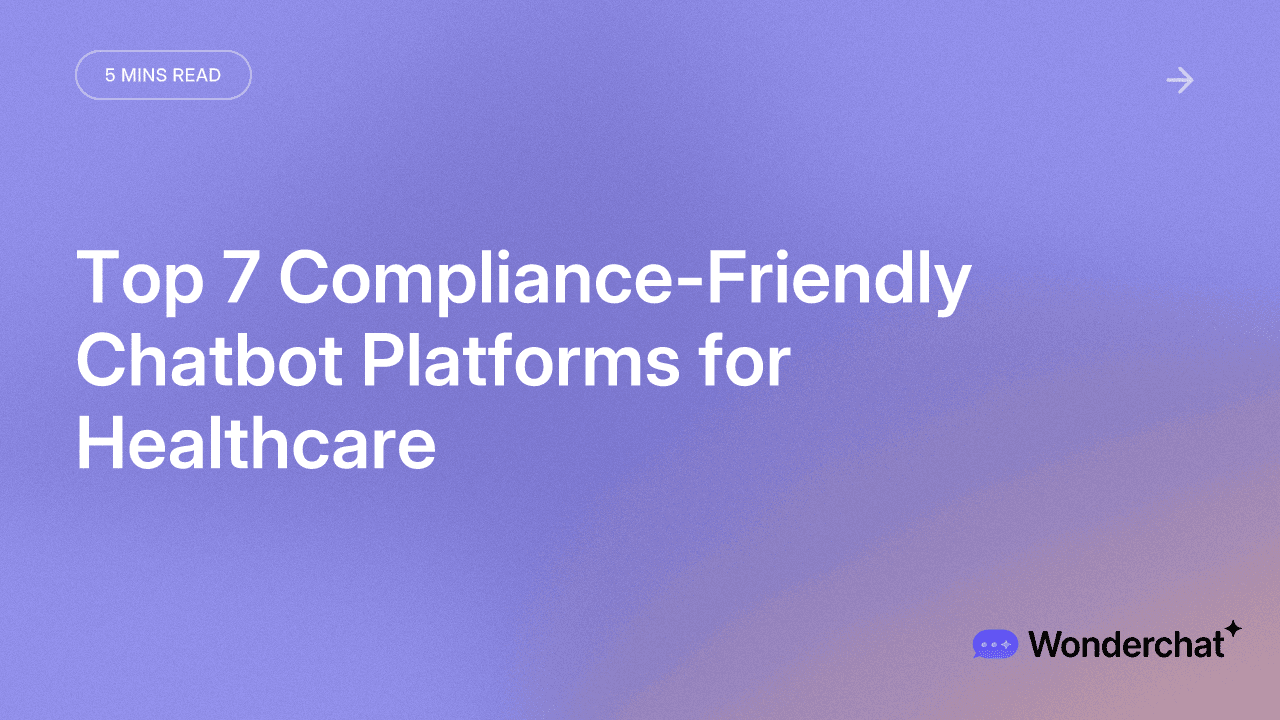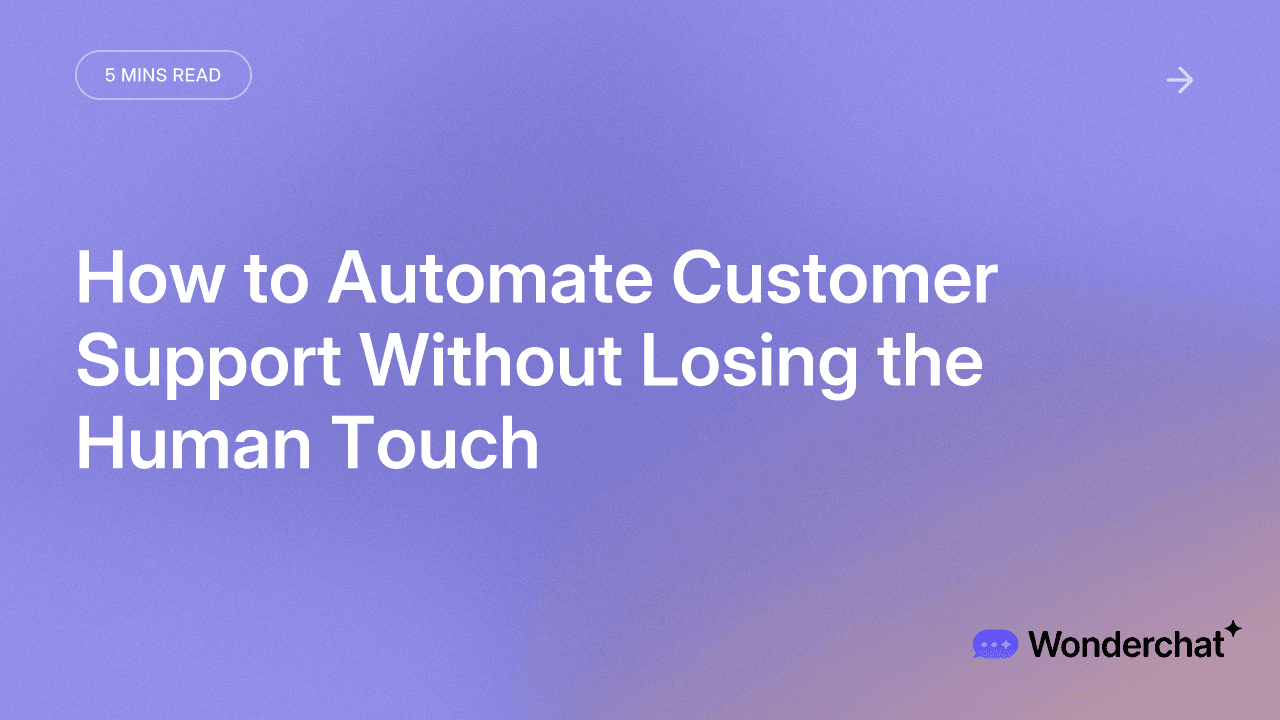Guides
Conversational AI vs. Chatbot: Which Is Right for Your Business?

Vera Sun
Oct 8, 2025
Quick Summary
This article explores the key differences between chatbots vs. conversational AI, showing where each shines in customer support. From FAQs to complex, multi-turn conversations, you’ll learn which option best suits your business. We’ll also highlight how Wonderchat blends the strengths of both with a no-code platform that delivers smart, scalable support.
Trying to Choose Between Chatbots & Conversational AI?
Have you ever felt frustrated by a chatbot that only gives canned answers, leaving your issue unresolved? You’re not the only one. Many businesses roll out chatbots expecting them to transform customer support, only to discover their limitations when conversations get complex.
On the other hand, conversational AI promises deeper, more human-like interactions, but it comes with higher costs and technical demands.
In this Wonderchat article, we’ll break down the real differences between chatbots and conversational AI, where each shines, and how to know which fits your business best. We’ll also show how Wonderchat blends both approaches, so you don’t have to compromise between simplicity and sophistication.
Why Listen To Us?
At Wonderchat, we’ve created a platform that helps businesses create intelligent AI agents that deliver real results. For example, the popular creator platform, Ko-fi, uses Wonderchat to deflect thousands of support tickets each month. This hands-on experience gives us a deep understanding of what works and what doesn't for customer support.

Chatbots vs. Conversational AI: An Overview
At first glance, chatbots and conversational AI may seem interchangeable. After all, they both automate customer interactions and provide instant responses. But in reality, they differ significantly in complexity, capabilities, and business impact.
Chatbots are built to follow rules or scripts. They excel at handling repetitive, straightforward tasks like FAQs, order tracking, or appointment scheduling. Their strength lies in speed, cost-effectiveness, and simplicity, making them ideal for businesses that need fast automation without heavy technical setup.
Conversational AI, on the other hand, takes automation a step further. Powered by natural language processing (NLP) and machine learning, it can interpret intent, understand context, and engage in multi-turn conversations. This allows it to deliver personalized, adaptive, and human-like interactions across multiple channels.
Here’s the key difference:
Chatbots give customers instant answers for predictable questions.
Conversational AI evolves with every interaction, offering context-aware support for more complex needs.
Both technologies improve efficiency and reduce workload for human agents, but the best choice depends on your goals. For some businesses, chatbots provide all the functionality they need. Others benefit from the depth and adaptability of conversational AI.
And then there’s a third option, a hybrid solution like Wonderchat, which combines the simplicity of chatbots with the advanced capabilities of conversational AI. This ensures your business doesn’t have to choose between ease of setup and intelligent, scalable support.
What is a Chatbot?
A chatbot is a program designed to imitate human conversation through text or voice. You see them on websites, in customer service chats, and on messaging apps, where they handle questions and assist users.
These bots offer instant, automated responses, so customers get help right away. They can also work around the clock, giving your business 24/7 support. With chatbots handling your common, routine tasks, you can save significantly on operational costs and manage many conversations at once.
There are two main types:
A rule-based chatbot follows simple "if-this-then-that" scripts, responding only to specific keywords or menu selections.
An AI-powered chatbot, on the other hand, is smarter. It uses natural language processing (NLP) and machine learning to understand varied phrasing and intent. However, they’re retrained periodically to improve, rather than learning in real time.
Overall, a chatbot is a simple tool that improves efficiency and gives users quick support in a digital setting.
What is Conversational AI?
Conversational AI is a technology that enables machines to understand and interact with people in a natural, human-like manner. Unlike basic chatbots that follow strict rules, a conversational AI system is an AI-powered chatbot capable of engaging in real conversations with context and purpose.
Think of it as a virtual assistant that can actually engage in multi-turn conversations, understand context, and offer personalized responses based on the user’s intent. It combines language processing with continuous learning to understand users’ queries and reply with coherent, human-like responses.
Chatbots vs. Conversational AI: Feature Comparison
Both automate customer communication, but at very different levels of sophistication.
Chatbots rely on scripts or decision trees. They’re designed for predictable, repetitive requests, like answering FAQs or checking order statuses. Their value lies in efficiency, deploying quickly, cutting costs, and handling large volumes of straightforward inquiries without human intervention.
Conversational AI goes further. Using natural language processing (NLP) and machine learning, it interprets context, intent, and phrasing variations. This allows it to support more dynamic, multi-turn conversations where customers don’t phrase questions the same way every time.
Technology | Chatbots | Conversational AI |
|---|---|---|
Description | Rule-based systems that follow predefined scripts to automate simple, repetitive tasks like FAQs or basic customer support. | Advanced systems that use natural language processing (NLP) and machine learning to understand, learn, and respond to more complex and dynamic interactions. |
Primary Focus | Automating basic tasks such as order tracking, FAQ handling, and appointment scheduling. | Providing personalized, multi-turn conversations that can adapt to user intent and context. |
Limitations | Limited by predefined decision trees, struggles with context or queries. | Requires more resources for setup and maintenance; can be more expensive to implement. |
Strengths | Quick to deploy, cost-effective, and ideal for high volumes of basic queries. | Can handle complex, dynamic queries and improve customer satisfaction over time through personalization. |
Best For | Simple, repetitive tasks where customers need fast answers. | Businesses that need to manage complex, multi-turn conversations or provide dynamic personalized support. |
Want to compare live chat and AI chatbots instead? Check our review - Chatbot vs Live Chat: Which Is Better For Customer Support?
Use Cases: Chatbots, Conversational AI, or Both?

When deciding between chatbots and conversational AI, the best choice depends on your business goals, the complexity of customer interactions, and your budget. Let’s break it down.
Best Fit for Chatbots
Chatbots shine when you need fast, simple, and cost-effective automation. They’re rule-based or basic AI-powered tools that respond instantly to common questions and are ideal for:
Handling simple queries: They excel at answering FAQs, providing business hours, or giving quick information like order status.
Cost-effective automation: They are typically more affordable and quicker to implement, making them perfect for businesses on a tight budget.
Low technical demands: Chatbots are easy to deploy and manage without extensive AI knowledge or development resources.
Straightforward interactions: They are well-suited for high-volume, transactional requests that don't require complex, multi-turn conversations.
Examples of Chatbots in Action
Here's how chatbots effectively manage straightforward tasks:
Tidio’s Lyro AI Agent
Lyro AI specializes in handling routine customer inquiries by pulling information directly from a company’s knowledge base and FAQs. It delivers fast, pre-written responses to common requests, like providing product details or confirming store hours, without requiring a human agent.
While highly efficient for large volumes of repetitive queries, Lyro cannot manage complex, multi-turn conversations, which exposes the limitations of basic chatbots.

Domino’s Pizza bot (Dom)
This classic chatbot efficiently handles basic orders like choosing pizza size or tracking delivery via Facebook Messenger, Alexa, and Google Assistant. However, when a customer requests more complex customizations, like a gluten-free pizza with specific toppings, it redirects them to contact the store. This highlights its rule-based limitations.

HelloFresh’s Freddy
Freddy is designed to assist with basic customer service tasks, such as sharing promo codes and answering frequently asked questions. It operates strictly within its predefined decision tree and does not learn from human interactions, making it highly efficient for managing routine inquiries.

Source: chatfuel.com
Best Fit for Conversational AI
Conversational AI is the superior solution when a business needs to handle complex, dynamic interactions that require a high degree of personalization and understanding. These systems are the better choice for:
Complex, multi-turn interactions: They are ideal for industries like healthcare or finance where customer queries are dynamic and require context-aware responses.
Personalization: Conversational AI can adapt to individual user preferences and data, offering a tailored experience that improves over time.
Omnichannel support: These systems deliver a consistent, unified customer experience across multiple platforms, from your website to social media.
Continuous learning: They learn from each interaction, improving their responses and accuracy over time, leading to better long-term outcomes.
Examples of conversational AI in action:
These examples showcase how conversational AI handles more complex, personalized tasks:
Ada Health’s Ada
This conversational AI helps users check symptoms and get personalized health guidance. Ada doesn’t just follow a script; it adapts based on what you share and learn from those conversations to provide increasingly accurate health assessments. This ensures a more sophisticated, context-aware experience.

Capital One’s Eno
Eno is a conversational AI that helps customers manage their finances. It learns from past interactions, tailoring its financial advice to the user’s spending habits and preferences.

This ability to learn ensures that the support experience becomes more dynamic and relevant over time.
Zalando’s VA
Zalando’s virtual assistant, powered by ChatGPT, offers a personalized shopping experience by suggesting outfits based on a user’s preferences. It even adapts its recommendations for specific events, such as suggesting attire for a wedding in Santorini.
This level of personalization makes the experience richer, ensuring that the AI proactively suggests options that match the user’s unique needs and context.

Lyft’s AI assistant
Lyft recently launched a conversational AI powered by Anthropic’s Claude to help with customer service inquiries for both riders and drivers.

The AI resolves common issues, handles initial queries, and smoothly redirects more complex cases to human agents. Since its launch, Lyft’s AI assistant has reduced customer service resolution time by 87%, managing thousands of requests daily. Its ability to scale and manage diverse inquiries makes it a powerful tool for providing efficient, consistent support, even during peak demand.
Wonderchat: The Best of Both Worlds
While chatbots and conversational AI each have clear strengths, many businesses don’t fit neatly into one category. That’s where Wonderchat comes in.
Wonderchat combines the simplicity of a chatbot with the intelligence of conversational AI, creating a hybrid solution that grows with your business. With our no-code setup, you can easily deploy a smart AI agent without any technical expertise.
Wonderchat also offers custom persona features, enabling you to tailor the bot’s tone and behavior to match your brand, ensuring a consistent customer experience. When complex queries arise, Wonderchat smoothly hands off to human agents, ensuring your customers always get the help they need, when they need it.

Hundreds of businesses are already seeing the benefits. For example, 10xTravel uses a Wonderchat AI agent to deflect up to 70% of its customer support queries. This hands-on approach helps your team reduce support costs while giving your customers instant, personalized help.
Build smarter conversations with Wonderchat
While both chatbots and conversational AI can automate conversations, the choice between them determines your customer's experience. A simple chatbot may save you some time, but it can quickly frustrate users with its rigid, scripted responses.
Wonderchat changes this completely. We combine the easy, no-code setup of a basic chatbot with the advanced, human-like abilities of a conversational AI. With us, you get a smart, effective tool that truly understands what your customers need. Instead of choosing between simplicity and power, you can have both.
Are you ready to build your own custom AI agent? Try Wonderchat today.

